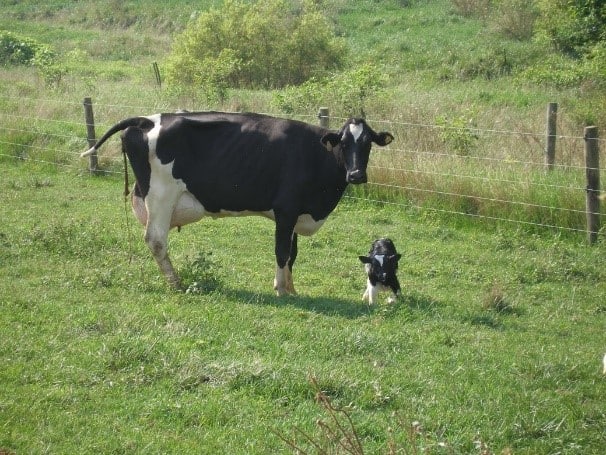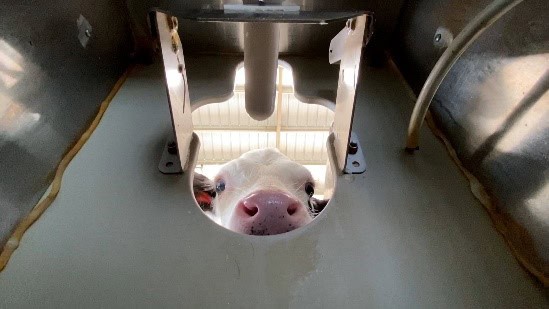Keep it clean!
All too often we tend to be too casual about cleanliness in raising preweaned calves, ESPECIALLY during their first week of life. Remember that this is a very young animal with a “biology” that’s not too different from human infants! They are born with a very limited (if any) microbiome that is in a state of flux during the first days or weeks of life. This is a time that can have a significant impact on their life and health if they get off to the wrong start!
Consider the following and how they might have an impact on the newborn and preweaned calf.
- Maternity environment. Where does the cow calve? Is it on a nice grassy pasture or a dark poorly bedded and ventilated box stall. The type and number of bacteria available to colonize the newborn calf can be very different. Research at Virginia Tech found that there are different populations existing in the lumen and the mucous layer of the intestine at levels as high as 100,000 cfu/g of tissue within hours of birth. Are they beneficial or harmful to future health?
- Colostrum should be either fed immediately after harvest or cooled to < 40F or 4C within 1 hour of harvest. As it comes from the cow, there are < 1,000 bacteria/ml. Studies by Minnesota researchers found that more than 90% of colostrum samples contained more than 100,000 bacteria / ml. Median total plate count weas 615,000,000 bacteria/ml! Other studies by this group and Virginia Tech researchers found a high, negative correlation between bacteria counts and IgG absorption. It is recommended that colostrum should contain less than 50,000 cfu/ml. The author has worked with farms that routinely achieve counts less than 5,000 cfu/ml.
Keys for “keeping it clean” and promoting successful colostrum management.
- Maternity environment. A well-drained, grassy pasture is probably optimal but not very practical on most dairy businesses throughout the year. The second choice is a clean, box stall deep bedded with clean straw that is cleaned often depending on calving pressure. This determines the type and number of bacteria that the calf may ingest shortly after birth.

- A clean calf. One farm that the author has experienced washes and blow dries every calf within 30 minutes of birth. Respiratory and digestive disease are exceptionally low in these calves.
- Colostrum handling. Follow protocols that one follows with the production of saleable milk! Milking into clean vessels or pipelines followed by prompt cooling or feeding. Increasingly farms have chosen to heat treat colostrum (slightly lower temperature for longer times) followed by prompt cooling and storage in clean vessels. Colostrum handling systems that include single use esophageal feeders and attached “bags” that hold 4 quarts are recommended. Nursing the dam? When does the calf “find” the teat and is it clean?
- Clean bottles. When calves are bottle fed are they clean enough?
- Simple cleaning protocols for all colostrum handling, storage and feeding are as follows:
- Rinse surfaces with lukewarm water (90F, 30C) ! Hot water causes biofilms to develop which can harbor bacteria.
- Wash thoroughly with hot (135F – 57C) , soapy water. Use a 1% chlorinated alkaline detergent. Scrub bottles
- Rinse again with cold water and a second rinse with acid solution (pH 2 – 3) and 50ppm chlorine dioxide.
- Drain and allow to dry.
- Liquid diet – Milk or milk replacer
- Milk may be best for calves, IF, quality is maintained. That means treating it with the same precautions used for saleable milk. This can be challenging in limiting bacterial growth between harvest and consumption by the calf! This requires rapid cooling after harvest, storage in clean vessels and heating to desired temperature (101- 110) for feeding to the calves. Milk replacer starts with lower bacterial growth and it’s easier to maintain this until the calf consumes it.
- Bottle or bucket feeding. Bottles have a distinct advantage in that the amount of time between mixing the diet and consumption by the calf is usually much less. Bucket feeding is problematic in that the vessel or tank used to transport milk to the calf must be cleaned as well as the bucket. Buckets are generally not cleaned between feedings or even daily. On most farms water may be fed in the same bucket as milk resulting in higher bacterial counts in the drinking water.

- Most autofeeder systems will automatically clean the interior surfaces of the system with a detergent and sanitizer and spray the nipple between calves.


- Waterers! They should be cleaned daily and rinsed with a dilute chlorine solution to retard bacterial or other organic matter growth.
- Calf housing. As milk is frequently limit-fed or fed only twice a day calves will frequently suck on the housing. Ideally there should be a “rest period” of at least a week between populating hutches with new calves.
- Biosecurity – We tend to forget this last factor. Let’s limit spread of disease from calf to calf!
- First use rubber gloves and change between calves. How often have you “trained” the calf to drink from a bottle by allowing the calf to “suck” your fingers?
- Second, start working with youngest calves first and then move to older calves
- Don’t allow personnel, including the DVM, that work cows and then move to the preweaned calf pen. Restrict outside visitors from contact with your calves. Insist on single use shoe covers or boots that have been sanitized well.
The ultimate proof that things are clean would be……. Would you drink it? If not why feed this to a young animal. This list seems to be overwhelming at times. However, it is recommended that systems be developed to address these challenges. Another question to ask would be would you rather spend time preventing disease or treating sick calves!



hi Bob
I bought 40 calves on the 12th April 2025
new farm
we woke up on the 13/4/25 one dead
next day 14/4/25. 2 dead
this has gone on all week
the lass on the dairy was cleaning calf bottles and tests in dirty dam water
I asked about the colour of the water and if it was a sterilant and she said it was just dam water
birds… ibis, chickens, ducks, cows all visit the dam
the water was a dark brown
so today a week on I have 15 dead
no amount of electrolyte in three days has pulled them out of it
I have 200 calves from a brother at different ages that are doing fine….so E 16mths old down to 6 mths old
I buy calves in at 2 days to 4 weeks..mostly dairy bulls…..and have had great success till now
Hi Noni, Sanitation is an often overlooked part of successful calf rearing. First water quality is so important. What you describe can easily contain viruses and/or bacteria particularly harmful to the calf and especially the youngest ones. Rarely will any detergent or sanitizer overcome the issues with water with a high soil or pathogen content.